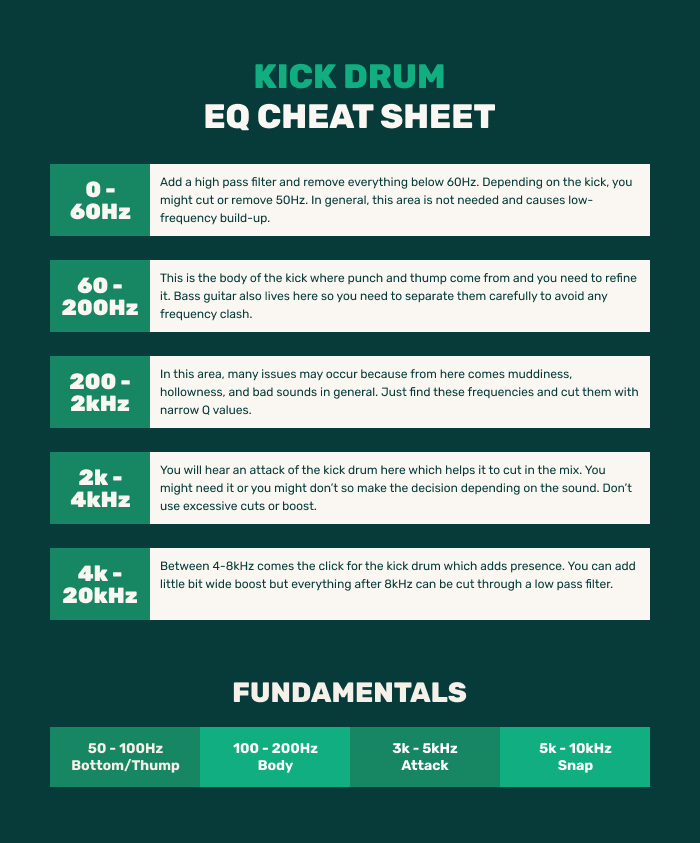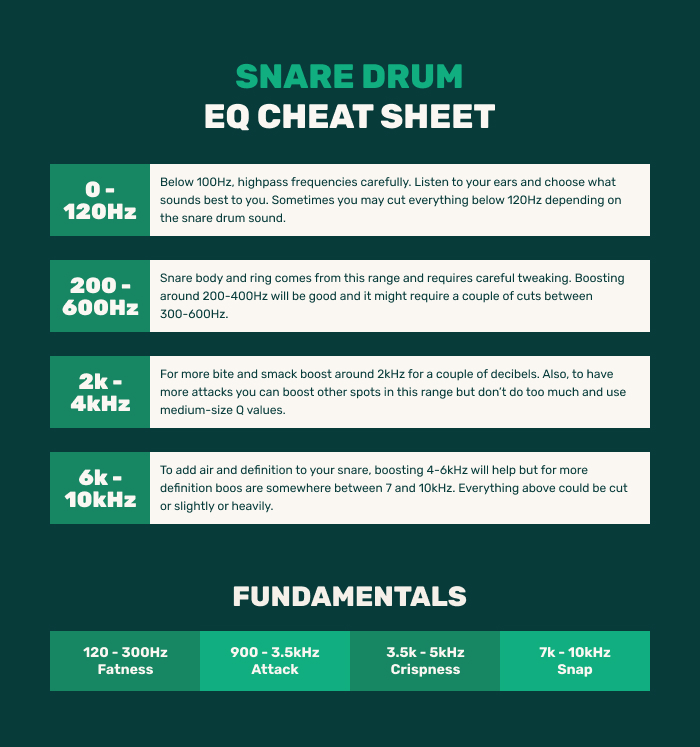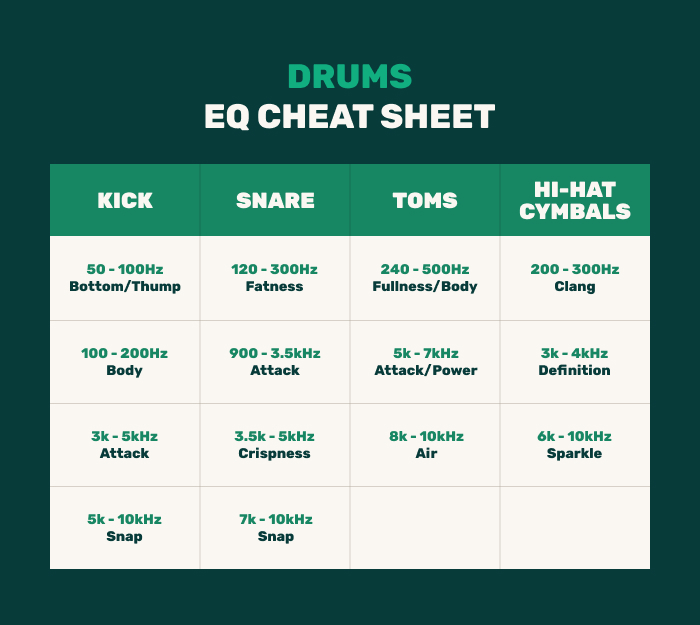When mixing drums it’s always a good idea to have some guide or a good starting point.
And drum EQ cheat sheet is a perfect guide for that purpose because it gives you the ranges of frequencies that are good for different drum parts.
Whether you are a mixing engineer or a producer, this drum frequencies guide will be very helpful.
Drum Frequencies
Here is the complete drum EQ cheat sheet with images which will help you to mix drums properly and much easier.
Kick Drum EQ Cheat Sheet
- 0-60Hz – Include a high-frequency filter and eliminate any sound frequencies below 60Hz. It may be necessary to trim or eliminate 50Hz, depending on the kick. Typically, this frequency range is unnecessary and leads to the accumulation of low-frequency noise.
- 60-200Hz – The core of the kick drum produces the punch and thump sounds and it requires improvement. The bass guitar sound is also located in this area, therefore, it’s necessary to distinguish the two sounds to prevent them from conflicting with each other in terms of frequency.
- 200-2000Hz – While mixing the kick drum, numerous problems can arise in this location due to the presence of murkiness, emptiness, and unpleasant sounds. Simply identify these particular frequencies and use narrow Q values to remove them.
- 2000-4000Hz – In this range, there is a noticeable kick drum sound that enhances its presence in the mix. It’s up to your judgment whether or not to use it, based on the sound you desire. However, be cautious not to make excessive cuts or boosts.
- 4000-20000Hz – The kick drum’s click, which enhances its presence, occurs in the range of 4 to 8kHz. It’s possible to apply a slight increase in the width, but frequencies above 8kHz should be removed using a low EQ pass filter.

Snare EQ Cheat Sheet
- 0-120Hz – Be cautious when filtering frequencies above 100Hz using a highpass filter. Trust your own perception and select the option that appeals to your ears the most. In certain situations, you may need to eliminate all frequencies below 120Hz, depending on the snare drum sound.
- 200-600Hz – To achieve the desired sound when mixing the snare, adjustments need to be made to both the snare body and the ring, which must be done with care. Enhancing frequencies within the range of 200-400Hz can be helpful, but it may also be necessary to make a few reductions between 300-600Hz.
- 2000-4000Hz – To add more aggressiveness and impact, increase the level at approximately 2kHz by a few decibels. Additionally, if you want more emphasis on the initial transients, you can increase the level at other frequencies within this range, but be careful not to overdo it and use moderate Q values.
- 6000-10000Hz – Boosting the 4-6kHz range can enhance the sound of your snare by giving it more air and definition. However, to achieve an even greater definition, boosting frequencies between 7 and 10kHz is recommended. Any frequencies above that range may be reduced to some degree.

Toms EQ Cheat Sheet
- 0-300Hz – Using a high-pass filter, eliminate all frequencies lower than 70Hz, and apply some boosting between 100-300Hz to enhance the thumping effect in the sound. However, it’s important to exercise caution and avoid excessive cutting or boosting.
- 3000-5000Hz – This is the range where the attack of the toms is located and improving their sound quality is achievable by amplifying frequencies in this specific area, particularly between 3 and 4 kilohertz. Even a minor alteration can significantly affect the sound output.
- 5000-20000Hz – Increasing the 6-9kHz range will provide greater force and increasing the levels from 5 to 12kHz will create a stronger sense of presence and openness. Furthermore, you can eliminate higher frequencies to declutter the mix and make room for other instruments.
Cymbals EQ Cheat Sheet
- 0-200Hz – you can employ a high pass filter to remove any frequencies below 200Hz as they do not contain any significant data for the cymbals. Depending on the specific cymbal, it may be necessary to remove even more frequencies.
- 200-400Hz – It’s possible to decrease this range by a small amount, but it’s recommended to enhance the frequencies properly. For instance, if you desire a subtle clicking sound, you may increase the range to 200-300Hz.
- 6000-15000Hz – To enhance the sound of cymbals in this region, it’s important to avoid excessive boosting. By reducing the frequency to around 10kHz, the sound can be made less unpleasant, while amplifying it at around 14 or 15kHz can give it a more airy and bright quality.
- 15000-20000Hz – You can choose to either leave this range alone or apply a low pass filter or a shelf filter to reduce the sound, depending on how it sounds. The majority of these frequencies do not contribute anything beneficial to the overall sound.

Conclusion
So, this drum EQ cheat sheet is a very handy guide to learning about different useful frequencies of drums. If you are a beginner mixing engineer, you can use this as a general guide, master it and use your own tricks.
